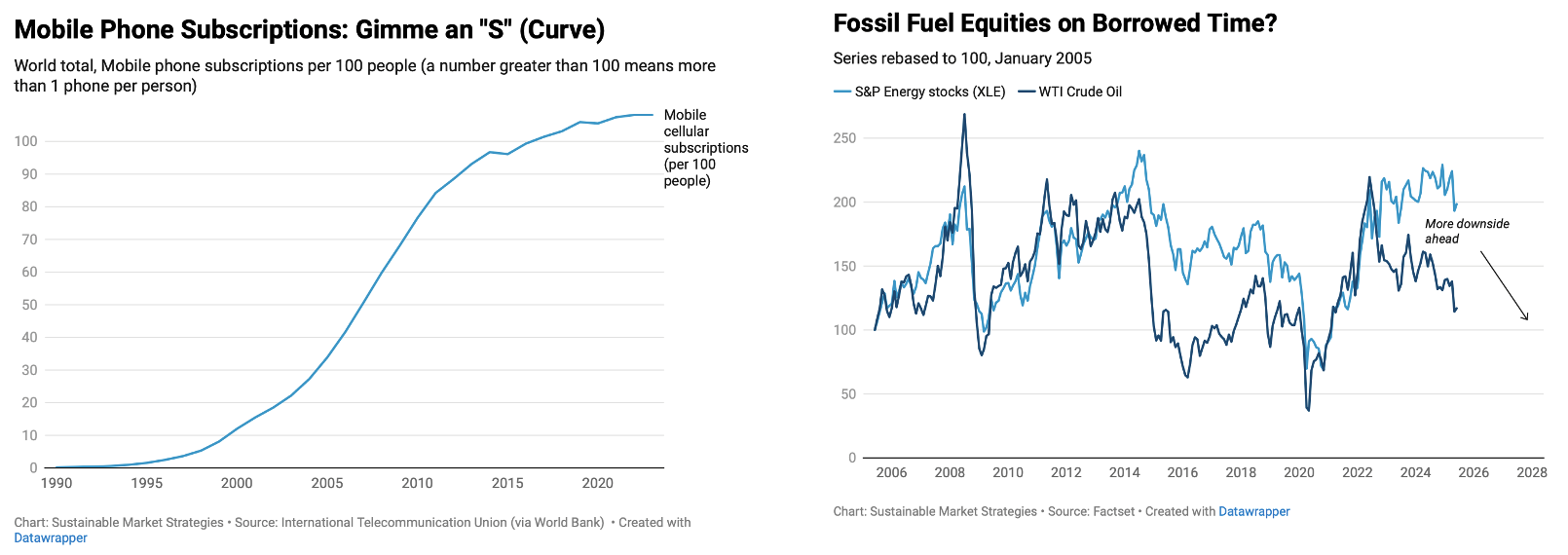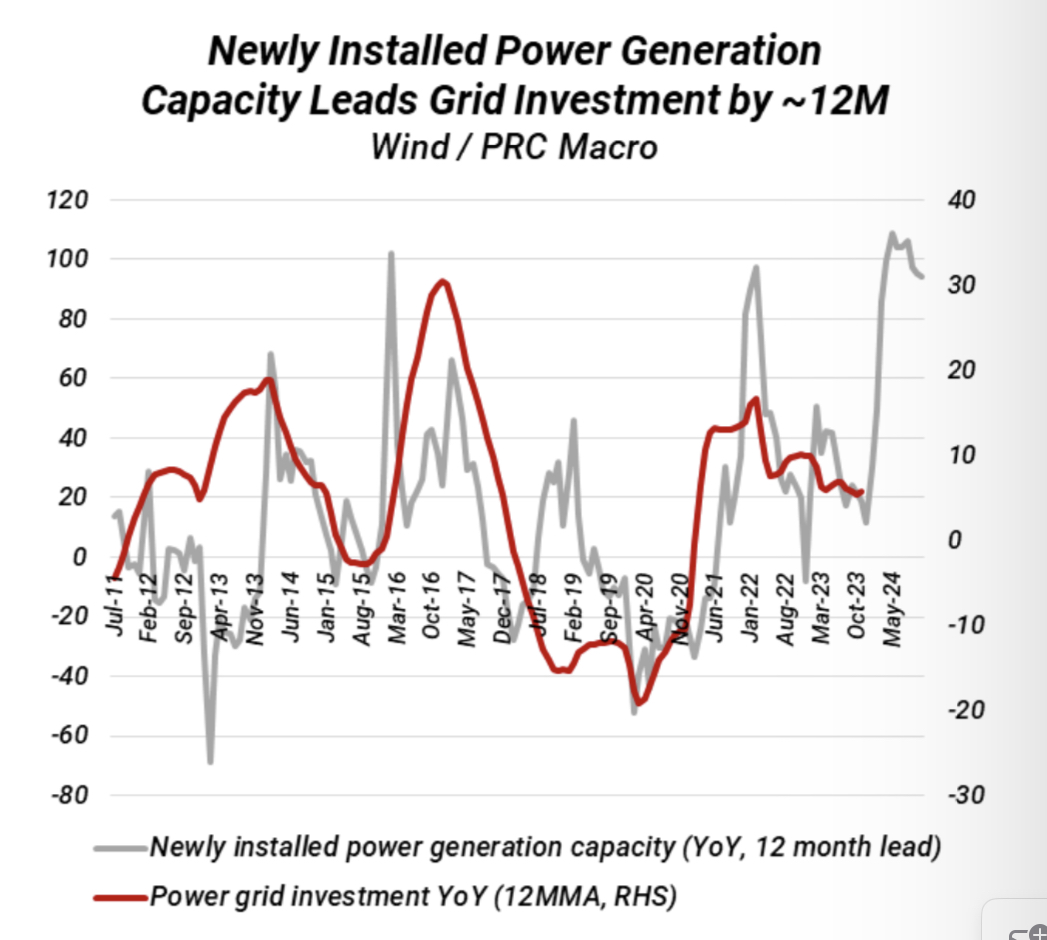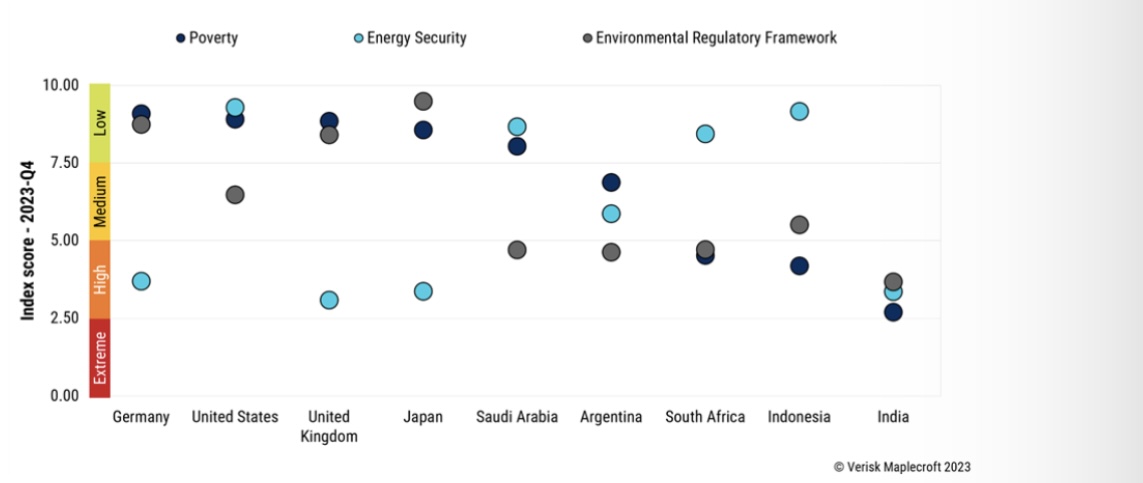Fortnightly Publication Highlighting Latest Insights From IRF Providers
Company Research
A transition tipping point
Renewable energy technologies may be entering the most exciting phase of the S-curve when it comes to aggressive gains in market share relative to incumbent fossil fuel sources. Just like mobile phone subscriptions (see chart), the S-curve demonstrates that investors must think about timing instead of assuming liner growth in order to obtain the best returns. EV sales in countries like Norway have already reached the end of their curve, and fossil fuels such as coal are seeing an inverted S-curve at play. Fossil fuel equities may be living on borrowed time (chart 2), and investors that have not yet diversified away from conventional energy assets should do so before the next wave of imminent write downs of stranded assets begins. The window is closing rapidly; act quickly.
Edition: 212
- 30 May, 2025
Can South Africa catch the critical minerals train?
Krutham (formerly known as Intellidex)
Despite having an endowment of 30% of the world’s critical minerals, South Africa is at serious risk of missing out on the increased demand due to inadequate planning, policymaking and strategic positioning. There is no coherent critical minerals strategy in place and Peter Montalto cannot see the nation offering anything meaningful to the US when it comes to trade talks. Significant investments, political will and policy reforms are needed to achieve Ramaphosa’s aim of bolstering the country’s raw materials strategy. The next G20 meeting is nearing and the new Department of Mineral & Petroleum Resources (DMPR) needs to move with greater speed in finalising the critical minerals strategy. It must aim to crowd in support and investment from the Global North (including the US) and take advantage of local opportunities such as the SA renewable energy masterplan implementation, the existing project pipeline and the Junior Miners‘ exploration fund.
Edition: 209
- 18 April, 2025
Healthcare, tariffs and Energy/Renewables policy
With the US Congress moving forward with its budget legislation, there are ongoing risks that healthcare providers and managed care and the renewable energy tax credits will be negatively impacted as Republicans look to offset the cost of tax extensions. Aldis Institutional's policy-focused events provide investors with timely and actionable insights into the DC landscape. This differentiated platform combines small group conversations with key stakeholders and policymakers, with real-time market commentary from Aldis' senior team. Recent and upcoming event topics include the outlook for Medicaid-levered MCOs and Hospitals, Trump tariff impacts on healthcare and other sectors and potential changes to Inflation Reduction Act tax preferences for renewable energy.
Edition: 206
- 07 March, 2025
India’s emerging nuclear opportunity
Industrials
Nuclear power currently contributes <2% of India's total electricity generation. With substantial budgetary allocation and the government's strong focus on execution and private partnerships, the country’s nuclear ambitions align well with its goal to foster clean energy. Iii’s channel checks suggest that several roadblocks present earlier are now being cleared and execution is moving in the right direction. To ride this theme, they focus on the Pumps Industry, a critical player in both traditional and renewable energy sectors. Opportunities span conventional power, solar water pumps, firefighting pumps for data centres, green hydrogen and reactor coolant pumps for nuclear plants. In this report, Iii delves deep into 3 companies with a strong presence in the industry: KSB, Kirloskar Brothers and Yuken India.
Edition: 197
- 18 October, 2024
Fuelling growth
Fossil fuel consumption continues to rise in absolute terms. Driven by the vast expansion of data centres and the AI boom, global power demand forecasts are being revised higher, in addition to the emergence of “negative feedback loops” where accelerated climate change leads to higher energy demand. Demetris Pachnis and Graham Turner explain that climate change is just one of the many risks facing sovereign bonds in coming years. Some would argue that interest rates need to be slashed to support a faster rollout of renewable energy projects, but the authors suggest that this may not suffice and could result in negative supply shocks as emissions continue to rise and climate change worsens. Dual interest rates for green energy are one potential option. But the bottom line is that technological change is not enough: global growth is far too strong for the world to see enough progress on emissions reductions.
Edition: 189
- 28 June, 2024
The age of AI and cheap energy
As Paul Krake pivots his gaze towards the horizon where AI and renewable energy reshape the global economy, it becomes apparent that the most lucrative investment opportunities may not solely reside in the technology creators but significantly in the technology adopters. The impending revolution will likely unfold within sectors like healthcare, banking and retail, which stand to gain immensely from integrating AI into their operations. Meanwhile, the transition to renewable energy presents a canvas for transformative investment in many industries. Companies that embrace renewable energy, not just as an environmental imperative but as a strategic asset for cost reduction and operational efficiency, will likely emerge as leaders.
Edition: 181
- 08 March, 2024
China: Off the grid
Investors have been worried about a potential contraction to grid investment in China after the State Grid (SGCC) suggested no incremental growth to investment this year. However, William Hess believes the State Grid only provided vague language as a result of the central government’s 2024 targets not yet being finalised. In the context of a massive build-up to renewable energy generation capacity against low connectivity, SGCC is one of the main actors who can close the gap, a glaring imbalance that will need to be resolved in the final budget. William reiterates his call that grid investment in China has been substantially underpriced by markets and could grow by 10% YoY or even higher. As a result, he continues to believe that copper prices could retest former resistance of USD 10,000 per metric ton as early as Q2 this year.
Edition: 179
- 09 February, 2024
The competing goals of the energy trilemma
Maplecroft looks at how DM and EM governments are trying to balance the competing goals of the energy trilemma – the push-and-pull between energy affordability, security and sustainability. From industrialised economies aiming to reduce GHG emissions and manage geopolitical risk, to developing economies trying to balance economic and social development needs against extreme climate risk, this trilemma poses multiple challenges, as summarised in the chart. The selected G20 countries face higher risk on at least one of the indices, underlining the trade-offs and challenges for governments (and their creditors) looking to deliver both an affordable and long-term-secure energy transition. In the coming year, we will need to see more grid investment in EMs to unlock power markets and allow for the scaling of renewable energy sources. In addition, energy security needs will prompt countries to tackle emissions from fossil fuel assets with CCUS tech and carbon market instruments.
Edition: 177
- 12 January, 2024
Building an all-weather environmental strategy
Rising interest rates were detrimental to renewable energy stocks in 2023, underscoring that using solely renewable energy plays as short hand for climate change investing is myopic and risky. The consequences of climate change go far beyond a low-carbon energy transition and the associated investment opportunities (and risks) are equally numerous and varied; building an environmental portfolio requires careful consideration of the macro backdrop. In the current macro context, the Sustainable Market Strategies team find US plays particularly compelling. Newly listed Veralto Corp, Owens Corning and Weyerhaeuser are three companies that should do well next year and are tackling three distinct environmental problems.
Edition: 175
- 08 December, 2023
Declining Businesses: Best short candidates
Atlantica Sustainable Infrastructure (AY) - Faces competition from new renewable energy companies and weaker than expected demand for electricity. Sales growth averages just above zero since 2017. EBITDA and FCF have declined since 2021. Trades at 34x 2024 earnings.
Olin (OLN) - Weakened demand in its core chlor-alkali business, increasing competition and higher raw materials prices. Sales declined for four quarters (incl. -35% drop last Qtr). While current year growth forecasts have been cut, out-year growth forecasts have been increased.
Seagate (STX) - The demand for hard drives has been declining as storage shifts onto the cloud. Sales have declined dramatically for five quarters. Margins have plummeted and leverage has shot up (when measured against collapsing EBITDA).
Edition: 166
- 04 August, 2023
The sky is falling
Kathleen Kelley comments that the green revolution needs to be re-evaluated and that a greater emphasis needs to be placed on decarbonisation, rather than just electrification. Other technologies, such as hydrogen and geo-thermal, need to be part of the solution and that a full analysis of life-cycle emissions is critical to investment decisions. Investment in renewable energy and EVs reached $1 trillion in 2022, but other sectors such as storage, clean fuels and clean energy outside of wind and solar need to find governmental support to grow until they are economically viable. The current trajectory of EVs and electrification is unsustainable and environmentally unfriendly, and considerably more research and development is needed for a successful green revolution.
Edition: 153
- 03 February, 2023
Utilities
Sumeet Singh runs the rule over this state-owned power producer as it looks to raise US$650m in its upcoming Indonesian IPO - PGE currently manages 13 Geothermal Working Areas with a total capacity of 1,877 MW. From an investment perspective, PGE will tick the renewable energy box and probably fall into a lot of ESG investment lists, which will aid demand for the deal. However, Sumeet notes that the company has regularly missed targets in the past, which blunts the attractiveness of its lofty future ambitions (aims to nearly double organic production capacity over the next five years).
Edition: 153
- 03 February, 2023
Ethereum Upgrade Boosts US Push to Green Cryptos
Ethereum has become the first major blockchain to switch from the most energy-intensive method of validating data, 'proof-of-work' (PoW), to the less energy-consuming 'proof-of-stake' (PoS). The changeover, dubbed "The Merge", comes as crypto faces growing criticism for its environmental costs. ETH underpins the second-largest cryptocurrency, Ether, and most Web 3.0 applications, such as decentralised finance (DeFi) and non-fungible tokens (NFTs). What next? Rapidly expanding crypto activity threatens Biden's decarbonisation goals. To align the sector with his plans for green electrification of US industry, the administration will develop standards for low energy intensity and renewable energy usage.
Edition: 145
- 30 September, 2022
The greatest malinvestment of all time
Ineichen Research and Management
While the investment in renewable energy could be the greatest malinvestment in the history of mankind, gas and nuclear are now considered clean in Europe, the inflationary Inflation Reduction Act in the US includes support for nuclear, and Japan's PM asked government to consider building new nuclear power plants. These are positive developments suggesting, speculating a bit, that the grotesquely anti-humanist cultish eco-silliness (Net Zero, Green New Deal, Fit for 55, governments burning food (biofuels), bird blenders, bovine flatulence capture backpacks, etc.) might reverse soon.
Edition: 143
- 02 September, 2022
FTSEurofirst 80 Index: Bullish & Bearish Themes
Technical Analysis
Recycling and Renewable Energy stocks such as Umicore, Vestas Wind and Siemens Gamesa are rallying from medium term support. Selective Seafood and Tobacco stocks remain defensive including SalMar, Mowi and Scandinavian Tobacco. Banks are generally rallying in ranges; favours CaixaBank and Sabadell which have already broken out and extend relative bases.
Industrials have broken uptrends and are now losing relative momentum such as Schneider, Atlas Copco and Alfa Laval. Luxury Goods renew their 4-month price and relative tops including Pandora, LVMH, Dior and Hermes. IT Hardware and Semiconductors renew their 5-month price and relative tops; SeSa, BE Semiconductor, Infineon and Nordic Semiconductor are highlighted.
Edition: 136
- 27 May, 2022
Why you may want to go LONG Australia
James Aitken comments on Australia’s resilience which suggests that the costs of a decoupling from China are far lower than many assumed. That fact will not go unnoticed by other countries or blocs (like the EU) that have differences with China. The ground is potentially fertile for Australia to become the world’s most trusted supplier of both commodities and renewable energy. Is the structural short in the AUD the largest, convex wrong-way risk in global currency markets?
Edition: 131
- 18 March, 2022
Energy
The trend is inevitable - in the near term, the market will increasingly favour renewable diesel over the biodiesel which dominates REGI’s portfolio. REGI’s unfavourable mix will lead them to post earnings disappointments. In the intermediate term, feedstock competition from oil majors will compress REGI’s margins further, leading to more disappointments. Longer term, hydrogen will displace diesel first in California (the LCFS market) then more broadly in the markets that are critical to REGI: transportation.
Edition: 128
- 04 February, 2022
Industrials
The Great Break Up - splitting GE into 3 independent, unconnected companies makes strategic sense and should unlock meaningful value for its shareholders. Based on 2023 estimates, Robert Sassoon’s analysis indicates a SOTP value for GE of ~$152 (50% upside). Despite the extended break-up execution timeline (Healthcare by 2023 and Renewable Energy & Power business by 2024), Robert makes a compelling case for investors to use the current share price lull to jump in and enjoy the catalyst-driven ride.
Edition: 124
- 26 November, 2021
China: Can decarbonisation QE offset the property contraction?
William Hess believes that the PBoC’s new decarbonisation relending facility will eventually morph into broader QE, with the central bank accepting CP, collateralised loans, receivables and even emissions quotes as qualifying collateral from commercial banks. The key question is whether or not renewable energy borrowers can offer enough collateral to offset what developers used to provide to support this “Green Leap Forward”. Watch closely.
Edition: 123
- 12 November, 2021
Ameresco (AMRC)
Energy
The technology agnostic renewable energy pure-play - an expanding portfolio of high-growth, high-margin energy assets makes AMRC a clear-cut and relatively safe way to play the broader energy transition. In addition to its favourable business model, Webber Research highlight the group’s significant backlog, visibility and momentum, as well as its early focus on the exciting RNG space. $80 TP is based on an EV/EBITDA multiple of 26x and 2022e Adj. EBITDA of $167m.
Edition: 114
- 09 July, 2021
How to play China in a post pandemic world
David Rosenberg explains that China’s short-term growth will be stymied by policy tightening and deleveraging which will pave the way for a more durable growth outlook. Beijing is looking to counter the headwinds with investment aimed at moving up the supply chain, and opportunities for investors will lie in areas like high-end manufacturing, robotics and biotech. Commitment to a greener future will also see renewable energy, carbon capture and storage provide good opportunities. David mentions that fixed income investors could also benefit from the huge bond market as it opens up to foreigners, a necessary step in establishing the Yuan as the global currency.
Edition: 113
- 25 June, 2021
Copper and the clean energy transition
If major economies meet their renewable energy targets, we will see copper demand increase by 2.5m tonnes by 2030. This is in addition to an extra 12m tonnes from increased EV takeup. Global demand will therefore increase 6.4% YoY until 2030. Concerns over substitutes for the metal emerging can be alleviated; copper will reign supreme for use in wires, batteries, grid lines and equipment.
Edition: 110
- 14 May, 2021
Renewable Energy Group (REGI)
Energy
Compressed stock not earnings - The Street has been infatuated with the rise of soybean oil without giving credit for REGI's ability to quickly switch between feedstocks (which has enabled them to achieve higher gross margins). Following better than expected 1Q results, Hamed Khorsand's bullish thesis remains intact. Having initiated coverage with the shares sub $25, they hit $120 earlier this year - the recent sell-off provides a highly attractive opportunity to purchase shares once again. 12-month TP $100 (80% upside).
Edition: 110
- 14 May, 2021


